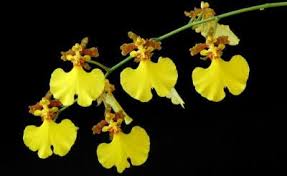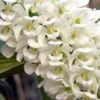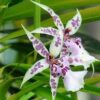# Exploring Sustainable Practices in Cultivating Dancing Lady Orchids

Sustainable gardening and cultivation practices have gained significant traction in recent years, particularly as individuals and communities become increasingly aware of environmental concerns. Among the myriad of beautiful plants that can be cultivated sustainably, the Dancing Lady Orchid (*Oncidium*) stands out for its aesthetic appeal and the unique challenges it presents to growers. This comprehensive guide will delve into the various aspects of sustainable cultivation practices specifically tailored for Dancing Lady Orchids, discussing the importance of sustainability in gardening, the specific needs of these orchids, and the methods to cultivate them responsibly.
## Table of Contents
1. [Introduction to Dancing Lady Orchids](#introduction-to-dancing-lady-orchids)
2. [The Importance of Sustainability in Orchid Cultivation](#the-importance-of-sustainability-in-orchid-cultivation)
3. [Understanding the Requirements of Dancing Lady Orchids](#understanding-the-requirements-of-dancing-lady-orchids)
– 3.1 [Light Requirements](#light-requirements)
– 3.2 [Watering Needs](#watering-needs)
– 3.3 [Soil and Nutrient Requirements](#soil-and-nutrient-requirements)
– 3.4 [Temperature and Humidity Preferences](#temperature-and-humidity-preferences)
4. [Sustainable Practices in Cultivating Dancing Lady Orchids](#sustainable-practices-in-cultivating-dancing-lady-orchids)
– 4.1 [Organic Fertilization](#organic-fertilization)
– 4.2 [Water Conservation Techniques](#water-conservation-techniques)
– 4.3 [Integrated Pest Management (IPM)](#integrated-pest-management-ipm)
– 4.4 [Using Renewable Resources](#using-renewable-resources)
5. [The Role of Community in Sustainable Orchid Cultivation](#the-role-of-community-in-sustainable-orchid-cultivation)
6. [Challenges in Sustainable Orchid Cultivation](#challenges-in-sustainable-orchid-cultivation)
7. [Conclusion](#conclusion)
—
## 1. Introduction to Dancing Lady Orchids
Dancing Lady Orchids, belonging to the *Oncidium* genus, are known for their unique flower formations resembling a dancer in motion. They are native to tropical and subtropical regions of Central and South America. With their vibrant colors and intricate patterns, they are popular among orchid enthusiasts and are often featured in floral arrangements, decorative displays, and as houseplants.
These orchids have specific growing conditions and care requirements, making them a challenging yet rewarding choice for gardeners. As the demand for orchids increases, so does the need for sustainable cultivation practices that protect the environment and promote biodiversity.
## 2. The Importance of Sustainability in Orchid Cultivation
Sustainability in gardening refers to practices that meet the needs of the present without compromising the ability of future generations to meet their own needs. In orchid cultivation, sustainability is vital for several reasons:
– **Environmental Protection**: Sustainable practices minimize environmental impact, helping to preserve natural habitats and reduce pollution.
– **Conservation of Resources**: Sustainable cultivation techniques promote the efficient use of water, soil, and energy, which are crucial for orchid growth.
– **Biodiversity**: By focusing on sustainable methods, gardeners can help protect native species and maintain ecological balance.
– **Quality and Health**: Sustainable orchids are often healthier and more resilient, leading to better blooms and overall plant vitality.
## 3. Understanding the Requirements of Dancing Lady Orchids
Before implementing sustainable practices, it’s essential to understand the specific needs of Dancing Lady Orchids.
### 3.1 Light Requirements
Dancing Lady Orchids thrive in bright, indirect sunlight. They prefer locations where they can receive filtered light, such as near east-facing windows. Too much direct sunlight can scorch their leaves, while too little can hinder flowering.
### 3.2 Watering Needs
These orchids require regular watering, but they are sensitive to overwatering. It is essential to allow the potting medium to dry slightly between waterings. This practice helps prevent root rot, a common issue in orchid care.
### 3.3 Soil and Nutrient Requirements
Dancing Lady Orchids prefer a well-draining potting mix, typically composed of bark, sphagnum moss, and perlite. This mix allows for adequate air circulation and prevents excess moisture retention. Fertilization should occur every two to four weeks during the growing season using a balanced orchid fertilizer.
### 3.4 Temperature and Humidity Preferences
Ideal temperatures for Dancing Lady Orchids range between 65°F to 75°F (18°C to 24°C) during the day and slightly cooler at night. They also thrive in humidity levels of 50% to 70%, making it essential to monitor and maintain these conditions for optimal growth.
## 4. Sustainable Practices in Cultivating Dancing Lady Orchids
Adopting sustainable practices is key to growing healthy and vibrant Dancing Lady Orchids. Here are some effective methods:
### 4.1 Organic Fertilization
Utilizing organic fertilizers helps maintain soil health and reduces the risk of chemical runoff. Compost, worm castings, and fish emulsion are excellent sources of nutrients for orchids. These organic options enrich the potting mix, providing essential nutrients without harming the environment.
### 4.2 Water Conservation Techniques
Implementing water conservation techniques is crucial for sustainable orchid cultivation:
– **Rainwater Harvesting**: Collecting rainwater in barrels can provide an eco-friendly source of irrigation. Rainwater is often free of the chemicals found in tap water, making it a great option for orchids.
– **Drip Irrigation**: Installing a drip irrigation system can help minimize water waste by delivering water directly to the plant’s roots.
### 4.3 Integrated Pest Management (IPM)
IPM is a sustainable approach to managing pests that involves monitoring and controlling pest populations through various means:
– **Regular Inspections**: Regularly check plants for signs of pests, such as spider mites or aphids.
– **Natural Predators**: Encourage beneficial insects, like ladybugs, to control pest populations naturally.
– **Homemade Remedies**: Use natural pest deterrents, such as neem oil or insecticidal soap, to treat infestations without harming beneficial organisms.
### 4.4 Using Renewable Resources
Incorporating renewable resources into orchid cultivation can enhance sustainability:
– **Sustainable Potting Mixes**: Use potting mixes made from renewable materials, such as coconut coir or sustainably sourced bark.
– **Biodegradable Pots**: Consider using biodegradable pots made from materials like bamboo or recycled paper, which break down over time and reduce waste.
## 5. The Role of Community in Sustainable Orchid Cultivation
Community involvement is essential for promoting sustainable practices in orchid cultivation. Local gardening clubs and organizations can play a significant role by:
– **Sharing Knowledge**: Organizing workshops and seminars to educate gardeners about sustainable practices and the specific needs of Dancing Lady Orchids.
– **Plant Swaps**: Hosting plant swap events encourages sharing and exchanging orchids, promoting biodiversity and reducing the demand for commercially produced plants.
– **Community Gardens**: Establishing community gardens where individuals can collectively cultivate orchids and share resources fosters a sense of community and encourages sustainable practices.
## 6. Challenges in Sustainable Orchid Cultivation
While the benefits of sustainable orchid cultivation are clear, several challenges must be addressed:
– **Availability of Sustainable Resources**: Finding sustainable materials and products can sometimes be difficult, especially in certain regions.
– **Pest Management**: Managing pests organically can require more time and effort compared to conventional methods.
– **Knowledge Gaps**: Many gardeners may not be familiar with sustainable practices or the specific needs of Dancing Lady Orchids, necessitating ongoing education and support.
## 7. Conclusion
Cultivating Dancing Lady Orchids sustainably is not only possible but essential for protecting our environment and ensuring the longevity of these beautiful plants. By understanding their specific requirements and implementing sustainable practices such as organic fertilization, water conservation, and integrated pest management, gardeners can enjoy the beauty of Dancing Lady Orchids while minimizing their ecological footprint. Through community engagement and ongoing education, we can promote a culture of sustainability in orchid cultivation, ensuring that these exquisite flowers thrive for generations to come.
By adopting these practices, we can contribute to a more sustainable future, preserving the beauty of our natural world while enjoying the vibrant colors and intricate forms of Dancing Lady Orchids in our homes and gardens.

